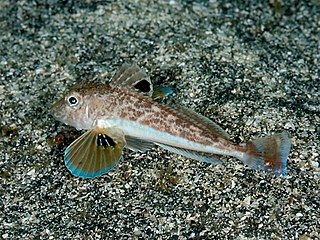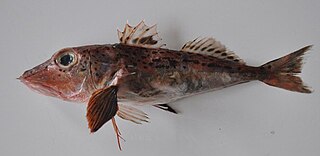
Triglidae, commonly known as gurnards or sea robins, are a family of bottom-feeding scorpaeniform ray-finned fish. The gurnards are distributed in temperate and tropical seas worldwide.

The scaly gurnard is a species of marine, demersal ray-finned fish from the family Triglidae, the gurnards and sea robins. It is found in the south-western Pacific Ocean.

The bluefin gurnard or Pacific red gurnard is a species of marine ray-finned fishes belonging to the family Triglidae, the gurnards and sea robins. Its Māori names are kumukumu and pūwahaiau. It is found in the western Indian Ocean and the western Pacific Ocean, being common around Australia and New Zealand at depths down to 200 metres (660 ft). The fish is one of the most important commercial fish species in New Zealand.

The tub gurnard, also known as the sapphirine gurnard, tube-fish, tubfish or yellow gurnard, is a species of marine ray-finned fish belonging to the family Triglidae, the gurnards and sea robins. It is found in the eastern Atlantic Ocean. It is exploited by commercial fisheries as a food fish.

Chelidonichthys, the smallscaled gurnards, is a genus of marine ray-finned fishes belonging to the family Triglidae, the gurnards and sea robins. These gurnards are found in the Eastern Atlantic, Indian and Western Pacific Oceans.

The spiny red gurnard is a species of marine ray-finned fish belonging to the family Triglidae, the gurnards and sea robins. This species is found in the northwestern Pacific Ocean where they occur at depths of from 25 to 615 metres. This species grows to a length of 40 centimetres (16 in) TL. This species is of commercial importance as a food fish.

Prionotus is a genus of marine ray-finned fishes belonging to the family Triglidae, one of two genera belonging to the subfamily Prionotinae, the searobins. These fishes are found in the Western Atlantic Ocean and eastern Pacific Ocean, in the waters off both North and South America.

The piper gurnard, also known as the piper or the lyre gurnard, is a species of marine, demersal ray-finned fish from the family Triglidae, the gurnards and sea robins. It is found in the eastern Atlantic Ocean and the Mediterranean Sea. It is the only species in the monotypic genus Trigla.

The red gurnard, also known as the East Atlantic red gurnard or soldier, is a benthic species of ray-finned fish belonging to the family Triglidae, the gurnards and sea robins. This fish is found in the eastern Atlantic Ocean, including the Mediterranean Sea and the Black Sea.

The jaggedhead gurnard is a species of marine ray-finned fish belonging to the family Peristediidae, the armoured gurnards or armored searobins. This species is found in the eastern Indian Ocean and the western Pacific Ocean. It is the only known member of its genus.

The streaked gurnard, also known as the African gurnard or rock gurnard, is a species of ray-finned fish belonging to the family Triglidae, the gurnards and sea robins. This fish is found in the eastern Atlantic Ocean and western Indian Ocean. This species is of commercial importance as a food fish.
The longfin gurnard, the long-finned gurnard or shining gurnard, is a species of ray-finned fish belonging to the family Triglidae, the gurnards and sea robins. This fish is found in the eastern Atlantic Ocean, including the Mediterranean Sea and the Black Sea. This species is of commercial importance as a food fish.
The lesser gurnard, or Quekket's gurnard, is a species of marine ray-finned fish belonging to the family Triglidae, the gurnards and sea robins. This species is found in the southwestern Indian Ocean and marginally in the southeastern Atlantic Ocean. This species is of commercial importance as a food fish.

Lepidotrigla kishinouyi, the devil sea robin, is a species of marine, demersal ray-finned fish from the family Triglidae, the gurnards and sea robins. It is found in the northwestern Pacific Ocean.
Lepidotrigla argus, the long-finned sea gurnard or eye gurnard, is a species of marine, demersal ray-finned fish from the family Triglidae, the gurnards and sea robins. It is found in the Indo-West Pacific Ocean.

Triglinae is a subfamily of demersal, marine ray-finned fishes, part of the family Triglidae, the gurnards and searobins. These gurnards are found in all the tropical and temperate oceans of the world except for the Western Atlantic Ocean.

Pterygotrigla polyommata, the latchet, butterfly gurnard, flying gurnard, lachet gurnard, pastry, sharpbeak gurnard, spiny gurnard or spinybeak gurnard, is a species of marine ray-finned fish belonging to the family Triglidae, the gurnards and sea robins. It is found in the southeastern Indian and southwestern Pacific Oceans.

The blackspotted gurnard, also known as the half-spotted gurnard, is a species of marine ray-finned fish belonging to the family Triglidae, the gurnards and sea robins. It is found in the Indo-Pacific region.

The large-scaled gurnard is a species of marine, demersal ray-finned fish from the family Triglidae, the gurnards and sea robins. It is found in the eastern Atlantic Ocean and the Mediterranean Sea.

Lepidotrigla papilio, the spiny gurnard, butterfly gurnard, Eastern spiny gurnard or Southern spiny gurnard. is a species of demersal marine ray-finned fish belonging to the family Triglidae, the gurnards and sea robins. This species is endemic to Australia.

















